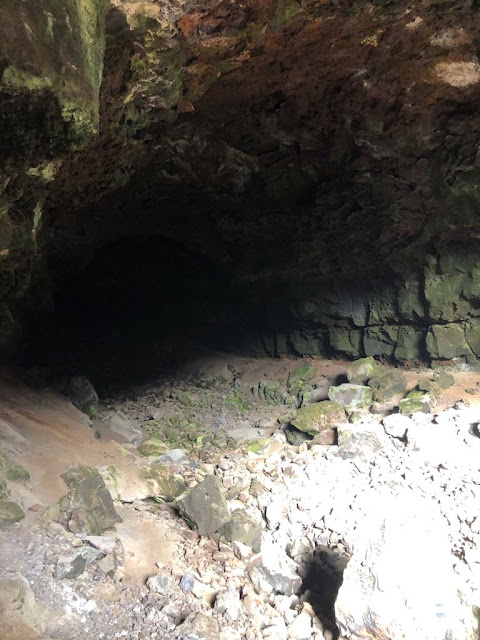Cueva de La Paloma and La Quesera de Bravo
La Cueva de La Paloma
La Cueva de La Paloma (translates to the pigeon’s cave funny enough), is near the coast of the municipality of Haría and has been eroded over the years. In the locality of Charco del Palo (Mala), in the northeast of Lanzarote, the cave can be entered by 3 main side entrances. There is one large main entrance that leads directly to the sea. The cave is named after the pigeons that live there, which can be found on the far end of the tube where the inland entrance is located. There are also other species of birds and the sound of their chirping is quite relaxing!
The caves are essentially large volcanic tunnels caused by the eruptions of the nearby volcano La Corona which erupted approximately 21,000 years ago, coinciding with the last glacial maximum. The streams flowed in the direction of the sea, on older volcanic materials emitted by Los Helechos and La Quemada, probably in favor of some ravine bed.
The caves have various forms of rock, minerals, and a lot of volcanic ash. I highly recommend going through the entirety of the cave and reaching the other side, the silence these caves offer, the variety of the rocky surfaces on the inside, and the definition of pure darkness is utterly breathtaking.
(pssst)… a little secret…. there is a book located around the midpoint of the cave which you can write down your name and the date you passed by it, I saw some signatures from a few fellow cave explorers dating back to the 1980s and 90s! Oh and look at these handprints on the walls:
A WORD OF CAUTION (I’m warning you!)
I have noticed there have been recent cave-ins (collapses), probably caused by the storms we have had on the island a few months ago. There are also a few large rocks that have cracked surfaces and look like they are about to fall.
Please always be careful when exploring these areas. I also highly recommend exploring these caves with an experienced guide (who knows the way by heart, so you do not get lost), to guarantee your safety and wellbeing.
If you do decide to go (with a group, that includes a guide by the way, and plenty of water, flashlights, cellphones, food, and clothing), it is spectacular. Just do not forget to let someone know you are exploring caves in case you take a bit too long to get back home 😉.
Quesera de Bravo
Similar to La Quesera de Zonzamas (and located far away from it), La Quesera de Bravo is in the heart of Malpaís de La Corona, near the Jameos del Agua, not far from a series of Casas Hondas (translates to deep houses), structures that are half below ground and a half above the surface, which the indigenous population would build. The Quesera de Bravo was located by M.L. Socas and T. Bravo and is therefore also known by the surname of this Canarian geologist.
The Majos (aborigines) made these constructions on a flat surface, carving in the basaltic rock, a series of elongated channels, parallel, several meters long, and which, in turn, have some small internal divisions.
Its name refers to the resemblance they have with a gigantic mold to make cheese, although, of course, they have nothing to do with such tasks. In fact, today its usefulness remains an enigma. Some people speculate the Quesera was used for religious gatherings, others believe it was a method of collecting water (which has always been a scarce and precious resource on the island), a few speculate it was a place to make a variant of Gofio (Gofio is a sort of Canarian flour made from roasted grains or other starchy plants, some varieties containing a little added salt. Gofio has been an important ingredient in Canarian cooking for some time, and Canarian emigrants have spread its use to the Caribbean and Western Sahara).
We still do not know exactly what the purpose of these fantastic structures was. What do you think? Let me know in the comment section below 😊
As always, go have fun and explore!
I hope you enjoyed this post!
If you'd like to check out some fun things to do in Lanzarote:
Click here :D
If want to see some Lanzarote-inspired designs on my online store, here's the link:
Click here :)
Are you an artisan Wine and Beer lover like me? If so...
Click Here!
Do you like eco-friendly custom-made, Lanzarote-based handbags?
Click here <3
If you'd like to donate to keep this blog going:
Click here :)
Wondering what to do in Lanzarote?
Click here!!!








Comments
Post a Comment